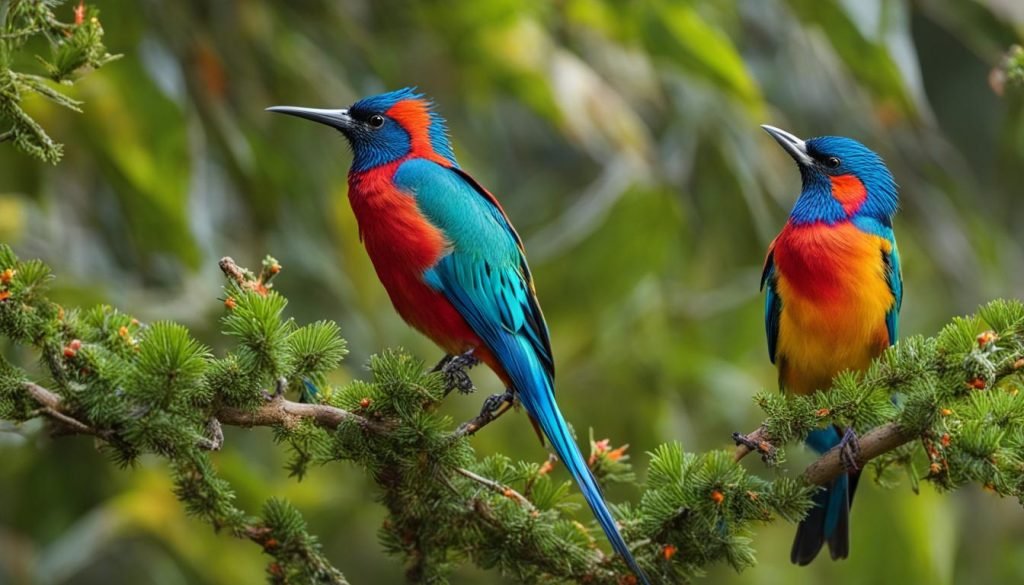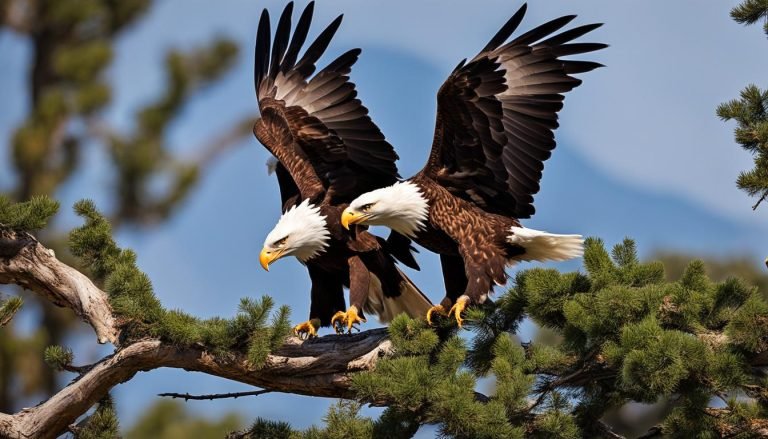How Do Birds Mate? – Learn More About Birds
Birds are some of the most fascinating creatures in the avian kingdom. Apart from their beautiful plumage and melodic songs, these feathered friends have intricate breeding behaviors that are vital for the survival of their species.
Have you ever asked the question how do birds mate? If so, you are in the right place. In this article, we will explore the fascinating world of avian reproduction and discover how these winged wonders ensure the continuity of their species.
Key Takeaways
- Birds have evolved elaborate mating rituals to attract mates and establish successful breeding pairs.
- Both male and female birds play crucial roles in the reproductive process.
- Birds have developed various reproductive strategies to increase their chances of successful breeding and ensure the survival of their offspring.
- Birds have specific breeding seasons, during which they engage in mating activities.
- Birds employ remarkable strategies such as brood parasitism and communal nesting to ensure the survival of their offspring.
The Mating Rituals of Birds

Birds have unique mating habits, and their breeding behavior and courtship rituals are fascinating to observe. These rituals involve complex behaviors, vocalizations, and displays that are used to attract and communicate with potential mates.
Bird Courtship and Copulation
Birds have a variety of courtship displays and vocalizations that they use to attract potential mates. Male birds typically perform elaborate dances, flights, or vocalizations to impress females. These displays communicate their strength, health, and ability to provide for offspring. Likewise, female birds use their plumage coloration, vocalizations, or dances to signal their interest in a male. Once a pair is established, the birds engage in copulation.
In most bird species, copulation is brief and takes place on the ground, branches, or in a nest. During copulation, the male bird climbs onto the back of the female and inserts his cloaca into the female’s cloaca to transfer sperm. Since the female birds reproduce via oviparous methods, the sperm and egg will come together inside the female bird’s body.
Bird Breeding Behavior
Bird breeding behavior is a broad term that refers to the variety of behaviors exhibited by birds during their breeding seasons. These behaviors range from selecting a suitable mate, building nests, incubating eggs, and caring for hatchlings. Many bird species exhibit monogamous mating habits, meaning they pair with one partner for the breeding season. Some species, however, are polygamous, meaning they mate with multiple partners.
Additionally, some birds engage in cooperative breeding behavior, where multiple adults will help care for young birds. An example of this is the Acorn Woodpecker, where multiple adults help build and defend nests and care for young hatchlings.
Bird Mating Habits
The mating habits of birds can vary widely depending on the species of bird. For example, some birds may engage in aerial displays, while others may display brightly colored plumage or sing intricate songs. Additionally, bird mating habits can vary based on environmental factors such as food supply and temperature. For example, some migratory birds breed only in certain geographic regions and during specific times of the year.
“Birds have evolved intricate mating rituals to attract mates and establish successful breeding pairs. These rituals involve complex behaviors, vocalizations, and displays.”
Ultimately, bird mating habits, breeding behaviors, and courtship displays are the result of millions of years of evolution.
Bird Quiz
How well do you know birds? Test your knowledge below!

Avian Reproductive Strategies

Birds have developed various reproductive strategies to increase their chances of successful breeding and ensure the survival of their offspring. These strategies involve bird nesting and mating habits, which can differ significantly among different species.
For instance, some bird species are solitary nesters and breed in isolated pairs, while others engage in communal nesting, breeding in colonies with other members of their species. Additionally, some bird species are serially monogamous, forming new breeding pairs each season, while others are socially monogamous, remaining with the same mate throughout their lifetime.
Avian reproductive strategies also involve the selection of suitable breeding sites and nest construction. Birds choose nest sites based on factors such as the availability of food and shelter, predator avoidance, and proximity to water sources. Nest construction varies significantly among bird species and ranges from simple scrapes on the ground to elaborate structures made of twigs, mud, and grass.
Incubation and parental care are also crucial aspects of avian reproduction. Incubation refers to the process of keeping the eggs warm until they hatch, and it can be carried out by either the male or female bird or sometimes both. Parental care involves feeding, protecting, and teaching the offspring to fly and fend for themselves.
Comparing Avian Reproductive Strategies
| Bird Species | Reproductive Strategy | Nest Type |
|---|---|---|
| Penguins | Socially monogamous | Simple scrape on the ground |
| Bald Eagles | Serially monogamous | Large nests made of sticks and twigs |
| Woodpeckers | Solitary nesters | Tree cavities or excavated holes |
As shown in the table above, different bird species have unique reproductive strategies and nest types adapted to their specific needs. Understanding these strategies can provide insights into the fascinating world of avian reproduction and birds’ complex behaviors and adaptations.
The Bird Mating Season

Birds have a specific breeding season, during which they engage in mating activities. The timing and duration of this season can vary depending on several factors.
The bird mating season is influenced by environmental conditions such as temperature, rainfall, and food availability. In general, birds will time their breeding season to coincide with the peak availability of food resources to ensure the survival of their offspring. For example, many birds in temperate regions breed in the spring when insects and other food sources are abundant.
Avian breeding patterns also vary depending on the species. Some birds are opportunistic breeders, mating whenever resources are available, while others have highly synchronized breeding seasons. For instance, many seabirds breed in large colonies during specific times of the year, allowing for better protection against predators and maximizing access to food resources.
| Bird Species | Mating Season | Location |
|---|---|---|
| Bald Eagle | November to March | North America |
| Emperor Penguin | March to August | Antarctica |
| Northern Cardinal | March to August | Eastern United States |
As shown in the table above, different bird species have distinct mating seasons that are often dictated by their geographic location and breeding strategies. Some birds, like the bald eagle, have a relatively short breeding season, while others, such as the emperor penguin, have a much longer breeding season to accommodate the harsh environmental conditions of Antarctica.
The Wonders of Avian Reproduction

Throughout this article, we’ve explored the intricate processes involved in the avian reproduction process, delving into the various aspects of bird breeding behavior, reproductive strategies, and mating rituals.
Bird Monogamy and Polygamy
One of the most intriguing aspects of avian reproduction is the prevalence of monogamous and polygamous mating systems. Some bird species, such as swans and eagles, form lifelong monogamous pairs, while others, such as birds of paradise and some waterfowl, engage in polygamous mating behaviors. Polygamous species may have multiple partners simultaneously or sequentially.
Cooperative Breeding
Another fascinating phenomenon in avian reproduction is cooperative breeding, in which multiple individuals care for a single brood of offspring. This behavior is commonly observed in birds such as meerkats and certain species of birds.
Brood Parasitism and Communal Nesting
Birds have developed unique strategies to ensure the survival of their offspring, such as brood parasitism and communal nesting. Brood parasitism involves laying eggs in the nests of other birds, while communal nesting involves multiple individuals sharing a single nest.
Overall, the avian reproduction process is a complex and fascinating topic that sheds light on the wonders of the natural world. From mating rituals and reproductive strategies to nesting and parental care, birds have developed remarkable ways to ensure the survival of their offspring and perpetuate their species.
More About Birds
- What Do Birds Eat? The Ultimate Guide to Avian Diets
- How Long Do Birds Live? Avian Lifespan
- 15 Facts About Birds That Will Surprise You
- Bird Quiz: How Well Do You Know Birds?
Frequently Asked Questions
What is avian reproduction?
Avian reproduction refers to the process by which birds reproduce and produce offspring. It involves mating, fertilization, egg-laying, incubation, and the rearing of young birds.
How do birds mate?
Birds mate through a process called copulation, where the male bird transfers sperm to the female bird. The exact method of mating varies among bird species, but it usually involves the aligning of cloacal openings and the transfer of sperm through the cloaca.
What are some courtship behaviors exhibited by birds?
Birds display a wide range of courtship behaviors to attract mates. These can include elaborate dances, vocalizations, displays of vibrant plumage, and impressive aerial acrobatics. Different bird species have unique courtship rituals that are specific to their mating strategies.
How do birds select nesting sites?
Birds select nesting sites based on various factors such as the availability of suitable habitat, food resources, protection from predators, and proximity to potential mates. Different bird species have different nesting preferences, with some building elaborate nests in trees or on the ground, while others use cavities in tree trunks or cliffs.
What is the bird mating season?
The bird mating season refers to the time of year when birds engage in mating activities. It is influenced by factors such as hormonal changes, availability of resources, and the need to synchronize breeding with favorable environmental conditions. The timing and duration of the mating season can vary among bird species and geographical regions.
Do all bird species mate for life?
No, not all bird species mate for life. While some birds, such as swans and albatrosses, form long-term monogamous pairs, others engage in polygamous relationships or exhibit cooperative breeding, where multiple birds participate in raising offspring together. The mating strategies and social structures of birds can vary greatly.
What is brood parasitism in birds?
Brood parasitism is a reproductive strategy observed in some bird species, where a female bird lays her eggs in the nest of another species. The host bird unknowingly incubates and raises the parasitic eggs along with its own. This strategy allows the parasitic bird to avoid the costs associated with incubation and parental care.
Do birds exhibit parental care?
Yes, many bird species exhibit parental care, where both male and female birds contribute to the care and protection of their offspring. This can include activities like feeding, incubating the eggs, defending the nest, and teaching the young birds essential survival skills. The level of parental care varies among bird species.







